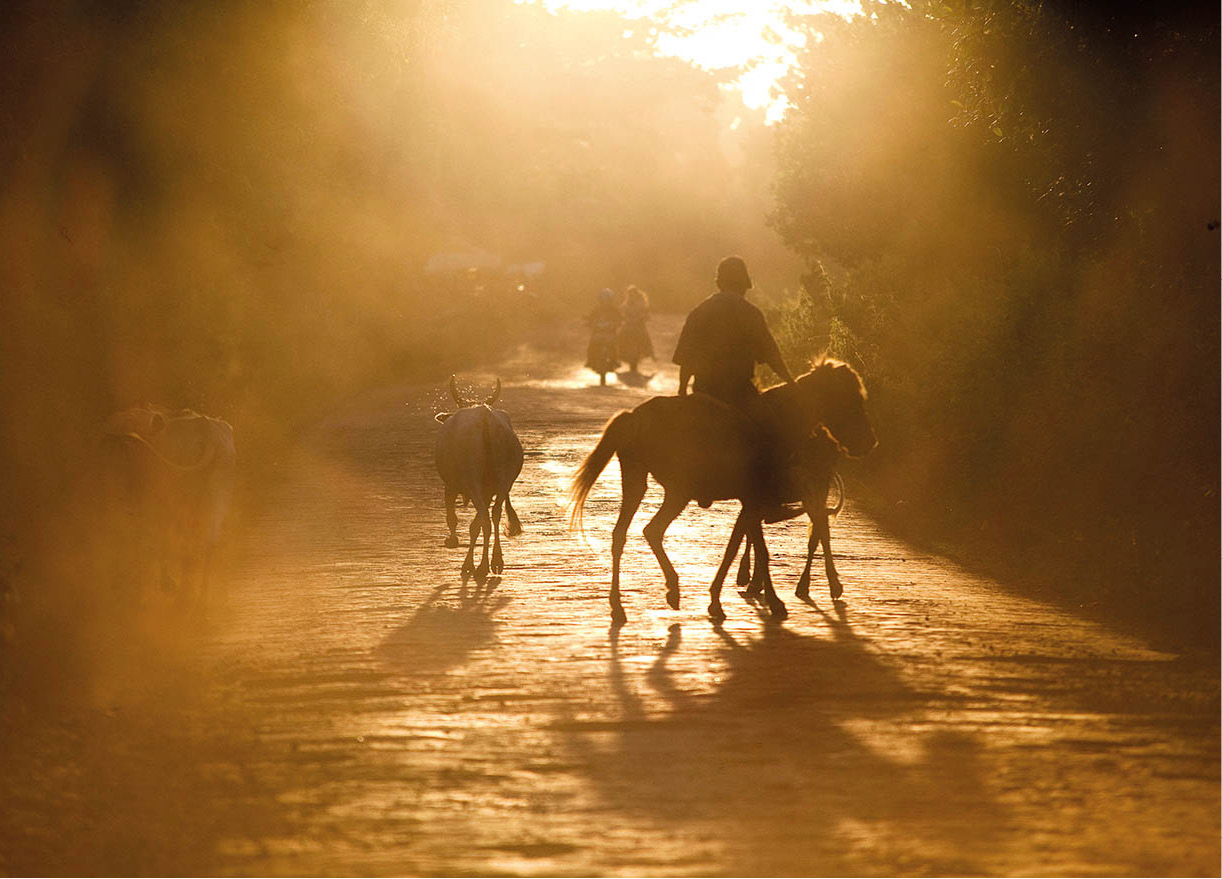Central and West Kalimantan are both huge provinces that are rarely visited by tourists due to poor infrastructure and lack of promotional effort by the tourist industry. Although Pontianak, the capital of West Kalimantan, is a busy trading centre, its equivalent in Central Kalimantan, Palangkaraya, isn’t much more than a small government administrative town. For both provinces the major industries involve deforestation – logging, palm oil and mining – placing them under the watchful eye of a carbon emissions-oriented world.
For adventurous souls, the still-extensive rainforests that survive in both areas hold many attractions. Six national parks protect remaining habitats, with orang-utans bringing the most international attention. But there are many more endangered species to search for, such as the proboscis monkey, sun bears, tapirs, clouded leopards and a wide variety of gibbons. Crocodiles and false gharials swim the rivers that criss-cross both regions, while pythons sun themselves in trees and hornbills soar above forest canopies.
Dayak tribes, who have their own deep-seated cultural heritage, also attract tourists. The Ngaju of Central Kalimantan, for example, held so fiercely to their religion, Kaharingan, that they fought the Indonesian government and won the right to have it acknowledged as one of the country’s officially recognised faiths. So strong is the Dayak influence in Central Kalimantan that the province also recognises their traditional laws. In West Kalimantan, many Dayak tribes live in the upper reaches of the Kapuas River and deep within the isolated national parks.
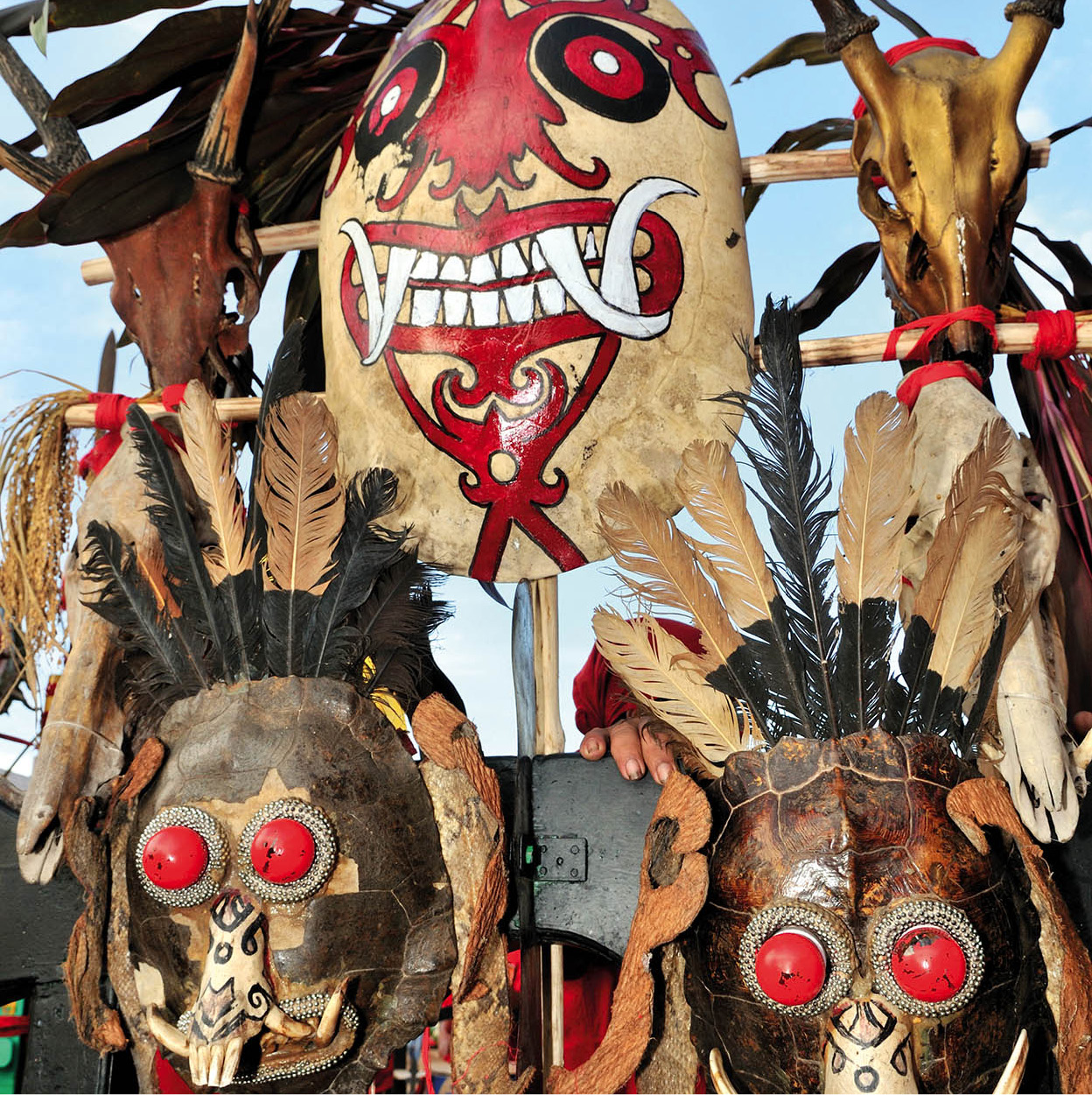
Dayak Tribe festival masks.
Getty Images

A basic rainforest path in central Kalimantan.
Robert Harding
Central Kalimantan
Kalimantan Tengah (Central Kalimantan), or Kalteng, is the Dayak province par excellence. For centuries dominated by the Muslim Banjarmasin, the local Dayak fought a short guerrilla conflict to obtain separate provincial status, which was granted to them by former president Sukarno in 1957. The Ngaju Dayak predominate among the province’s several groups. Many were converted to the Protestant faith and became aware of their cultural identity thanks to German missionaries in the late 19th century.
Fact
There is a longhouse at Tumbang Anoi that was the site of a conference of all Kalimantan’s Dayak tribes called by the Dutch over 125 years ago. During this meeting a treaty was signed which ended the head-hunting commonly practised in those days. The longhouse has an interesting collection of sandung funerary posts.
Palangkaraya
The capital of Kalteng, Palangkaraya ! [map], has a population of around 200,000. Most of the commercial and business activities are concentrated in the Pahandut district, where a village once existed on the Sungai Kahayan before the place was selected as the provincial capital.
There are two docks on the river: Rambang, the lower one, serves boats heading downriver. Flamboyant is for upstream passengers. While in Palangkaraya, see Dayak artefacts at Museum Negeri Propinsi Kalimantan Tengeh Balanga (Museum Balanga; Sat–Thu 9am–4pm, Fri 9–11.30am). It is located near the Pasar Kahayan market at the 2.5km mark, just off the paved road running parallel to the river.
Dayak country is found up the Sungai Kahayan. There are daily passenger boats heading upriver as far as Tewah. Speedboats that allow stops along the way can also be chartered. From Tewah, where regular river traffic usually stops, hire a motorised canoe to Tumbang Mire and beyond, to the traditional Ot Danum Dayak land with longhouses and funerary structures. Travel here depends essentially on water levels. Try to reach Tumbang Korik, on a tributary, or Tumbang Maharoi, the last village on the river.
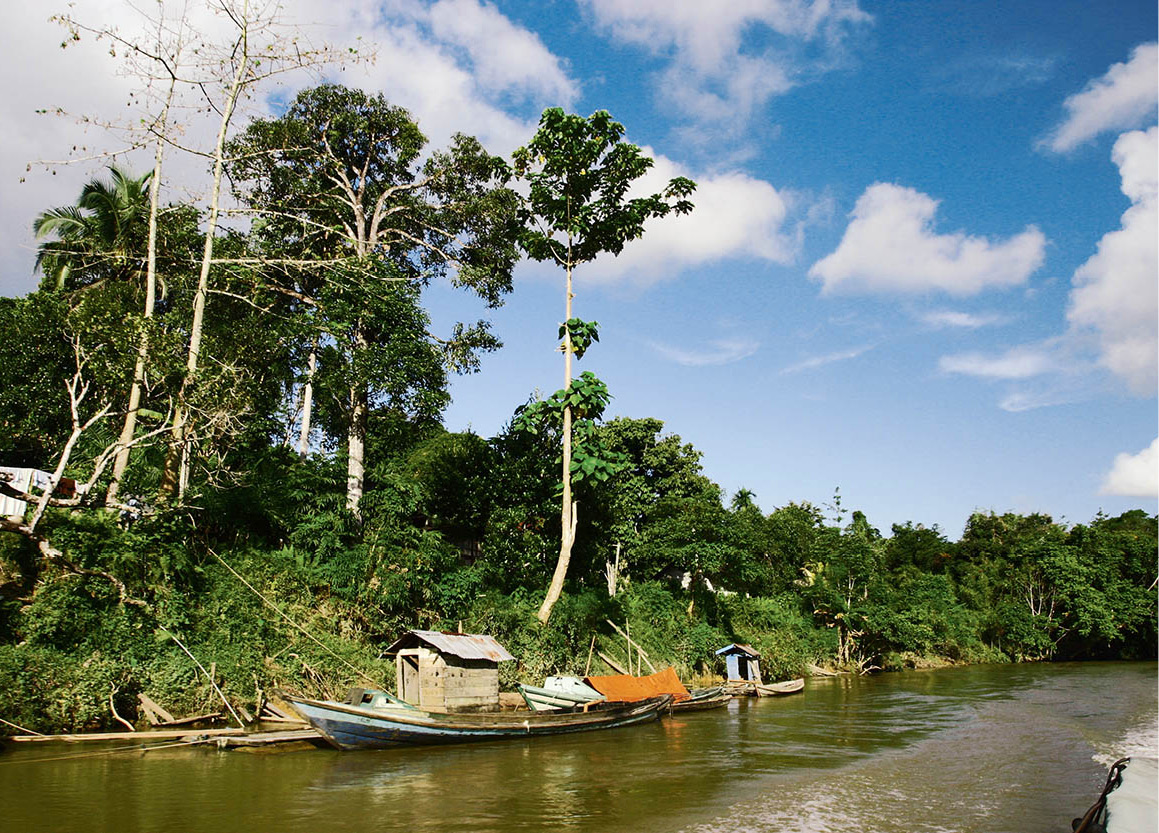
The forest at Tumbang Samba.
Indonesian Tourist Board
Alternatively, let a tour operator do all the logistical work, something that is difficult without a basic knowledge of the Indonesian language. Otherwise, from Palangkaraya you can arrange boats on the Katigan (Rangkan) River for two full days, camping or staying overnight in village homes in Tumbang Samba and Penda Tangaring. It is a 3-hour hike from Penda Tangaring to a Dayak longhouse built in 1870 by a member of the Kahayan Dayak tribe. In front of the longhouse is a mausoleum where the bones of ancestors were placed following the customary tiwah funerary ceremony. Sepundu poles, carved to represent humans, were used in days gone by to tie up sacrificial animals (and slaves) awaiting their fate.
The Borneo Orang-utan Survival Foundation has a rehabilitation centre at Nyaru Menteng, 28km (17.5 miles) north of Palangkaraya, which can only be visited with a permit acquired in advance. Visitors are not allowed to come in close contact with the orang-utans, but the information centre is open to the public on Sundays, and many local people enjoy strolling through the forest.
South of Palangkaraya, Sebanggau National Park is centred on a river by the same name, which is black from decaying plant material. The park is an important research area for its large population of orang-utans and agile gibbons, but it is difficult to reach with virtually no infrastructure to facilitate tourism.
Tanjung Puting National Park
Orang-utan-watching in Tanjung Puting National Park @ [map] is the province’s major attraction. The starting point is Pangkalanbun, which is accessible by air. Scheduled arrivals and departures ply routes to and from Pontianak, Ketapang, Banjarmasin, Jakarta, Semarang and Surabaya.
Fact
Camp Leakey was established by Birute Galdikas in 1971 for her research into orang-utan behaviour. A disciple of Louis Leakey, whose life’s work was to establish a link between humans and apes, Galdikas was the only scientist among his protégés, who also included Jane Goodall and Dian Fossey. For 20 years Galdikas continued her research here, and although she no longer works in the camp, her presence brought it international renown.
Once in Pangkalanbun, it is necessary to obtain an entry permit at the park office. From there, hire a taxi for the 20-minute drive to Kumai, a riverside village that is the entry point to the park, a Unesco Biosphere Reserve. At the harbour, either hire a klotok (local motorised boat) or a speedboat to go upriver. While speedboats are faster, the noise they generate may nullify whatever chances there are for birdwatching or quiet enjoyment of the nipah and mangrove ecosystems along the muddy jungle river.
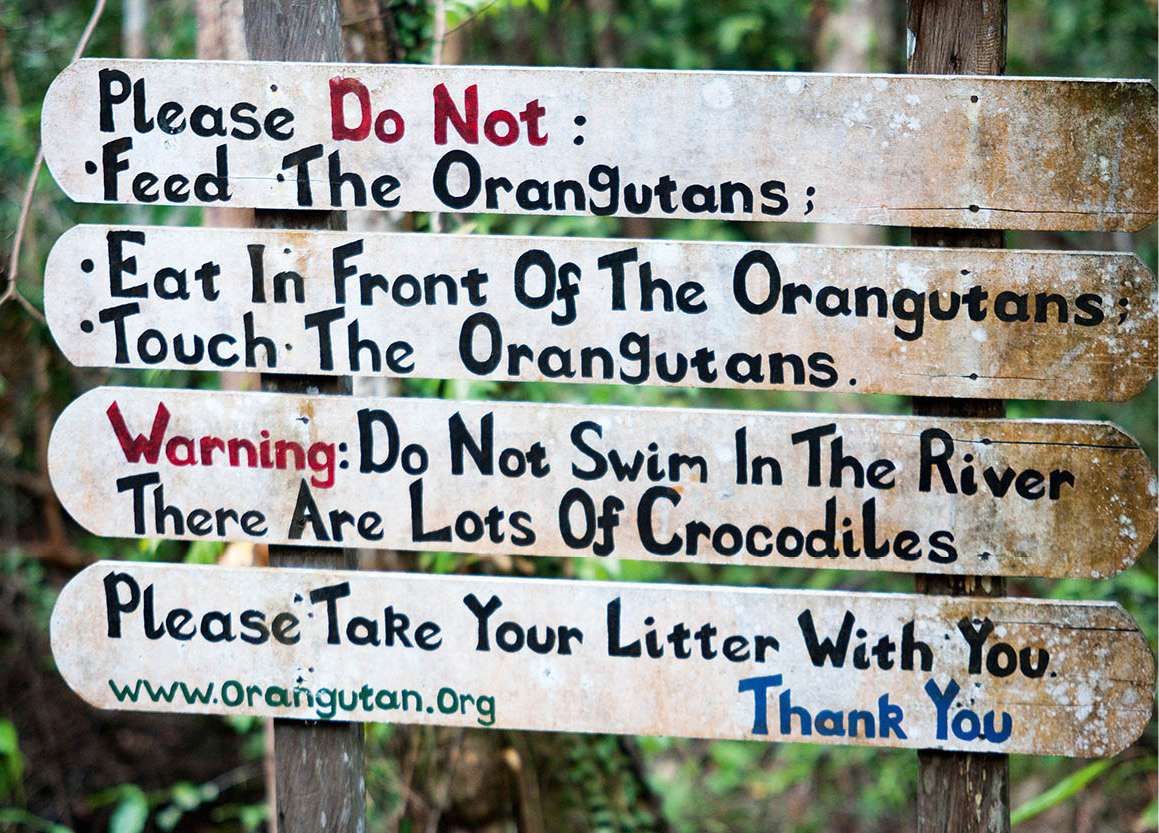
The visitor notice at Camp Leakey.
Corrie Wingate/Apa Publications
There is one lodge and a homestay on the river, both with basic amenities and food service, or serious adventurers can elect to sleep aboard the klotok. If choosing the latter, buy supplies in Kumai (include enough for a two-man boat crew), and one of the crew will prepare simple meals.
Friends of the National Parks Foundation (FNPF) runs a small guest house at the Tanjung Harapan post and can also arrange upriver expeditions. All money received helps support FNPF’s conservation and village projects.
Fact
Mercury from illegal gold mining pollutes the Sekonyer River, endangering not only flora and fauna, but also people. The once-beautiful mahogany-coloured water leading to Camp Leakey is now a muddy brown.
The highlight of the Tanjung Puting National Park experience is the orang-utan feeding sessions (check times upon arrival) at one of the three park outposts. The first, Tanjung Harapan – directly opposite the Sekonyer River Ecolodge – cares for orphaned infants and new arrivals and has a visitor information centre. By far the most famous of the three, Camp Leakey can be somewhat of a circus during high season (June–August), with visitors who are less conservation-oriented clamouring to walk down jungle paths to see the red apes in action. Older orang-utans, sometimes with their offspring, can be found at Pondok Tanggui. During the feeding sessions at Camp Leakey and Pondok Tanggui, orang-utans that hover near the stations are offered bananas and milk to supplement seasonal lack of food in the forest. Allowing tourists the experience achieves an additional benefit: raising awareness of the plight of orang-utans and the shrinking forests. It is a joy to sit quietly and watch as semi-habituated orang-utans, lumbering hand over heavy hand through the trees, arrive at the feeding platforms. Their gregarious antics can be amusing.
Fact
Local guides at all three stations can be hired for a small fee to conduct treks through Tanjung Puting’s peat swamp forest. While it is difficult to spot wild orang-utans, as they live solitary lives high in the treetops, there is other interesting fauna and flora such as pitcher plants, ironwood trees, insect nests and plants used for medicinal purposes.
Best wildlife viewing
The best wildlife viewing is possible from the river. At sunrise, proboscis monkeys begin their day’s foraging. Occasionally, one will belly-flop into the river, his lightly webbed toes enabling him to swim against the currents. During these times, the birds are particularly active. Azure-hued kingfishers, greater coucals and three species of hornbills are among the 220 species recorded in the park. Along the riverbanks, watch for mudskippers and archerfish, pythons sunning themselves on branches, and estuarine crocodiles. In the late afternoon, the groups of proboscis monkeys, one male and his female harem per tree, settle in for the night and are easy to spot, with their long straight tails hanging down from their branch roosts. For a sublime jungle river experience, ask the boatman to stop the engine for a while to allow the boat to drift quietly. Sunsets can be spectacular.

Siamese crocodiles in the Kapuas river.
Emmett Brown
West Kalimantan
Kalimantan Barat (West Kalimantan), or Kalbar, covers another huge area, enveloping essentially the Sungai Kapuas Basin. In the 1600s, diamond fields attracted the attention of the Dutch, and these were quickly depleted. In the 1700s, the sultan of Sambas imported Chinese coolies to work alluvial gold deposits, which continued until the beginning of the 19th century. The 18th century also saw Pontianak established as the resistance headquarters for Dutch efforts to stave off advances from Englishman James Brooke, the ‘White Raja’, who ruled the neighbouring territory now known as Sarawak.
Dominated by the Kapuas, Indonesia’s longest river, Kalbar’s transport, communications and economy revolve around its waterways.
Fact
Twice annually between 21 and 23 March and between 21 and 23 September, when the sun crosses the earth’s zero-degree equator line, Pontianak’s Tugu Khatulistiwa (Equator Monument) casts no shadow. Ceremonies and performances celebrate this unusual phenomenon.
The provincial capital, Pontianak £ [map], lies near the sea at the junction of branches of the Kapuas and Landak rivers, their bridges giving views of riverborne markets, floating houses and a working port. Pontianak is an unusual name. Taken from the Malay ‘Perempuan Mati Beranak’, it means a female vampire who died during childbirth. Believed to haunt the town, precautions are taken to prevent her and her kind from rising and becoming ghosts.
While the city’s Museum Negeri (State Museum; Tue–Sun 8am–3pm), housing prehistoric and historic artefacts as well as ceramics, is worth a visit if there is time, the old wooden Keraton Kadriah or Istana Qadriah (Sultan’s Palace) on the far side of the Kapuas from downtown, is excellent and a must-see. The main entrance to the palace is in the shape of a Portuguese gate. The istana belongs to the descendants of Syarif Abdul Rahman, an Arab rover who founded the city in the late 18th century with Dutch backing.
Located bang on the equator, the coastal road heading north 3km (2 miles) from Pontianak towards the Pinyuh river passes a strange-looking monument called Tugu Khatulistiwa (Equator Monument). Having become somewhat symbolic of Pontianak, miniatures of the monument are available in local shops. About 120km (75 miles) northwest of Pontianak on the road to Singkawang is Kampung Saham, a Kendayan longhouse settlement with a beauty all its own. At Mempawah is the Amantubillah Palace, built in 1780, and the Juang Mandor Cemetery commemorating the 21,000 people killed in Japanese skirmishes and buried in mass graves.
Just outside Singkawang $ [map] are a couple of huge ceramic kilns turning out vases and jars. The large Chinese population in this area descended from the miners who arrived here to work during the gold rush at the beginning of the 19th century. There are several striking Buddhist temples in the area.
Near Singkawang, Pasir Panjang beach is ideal for swimming. Also in the vicinity, the Gunung Poteng hill resort is a great place for nature-lovers with its cool, fresh air. Raya Pasi is home to a variety of flora and fauna, including the parasitic Rafflesia, the largest flower in the world. Singkawang is also near the Lo Fat Fun, Niyut and Prinsen nature reserves.
North of Pontianak (5 hours by car) is Sambas, a former sultanate and pirate’s lair. There is not a lot to see in Sambas, and the town is a centre for the production of kaim sambas, a fine textile interwoven with gold and silver threads. Similar to the Malay songket and those from Palembang (Sumatra), the cloth is sold at a much lower price by the weavers in their homes than in Pontianak shops.
The Istana Sambas, a palace remnant of the former kingdom, is still in good condition and houses many antiques. Adjacent to the palace is a mosque. Both are similar to the ones in Pontianak, though not as grand.
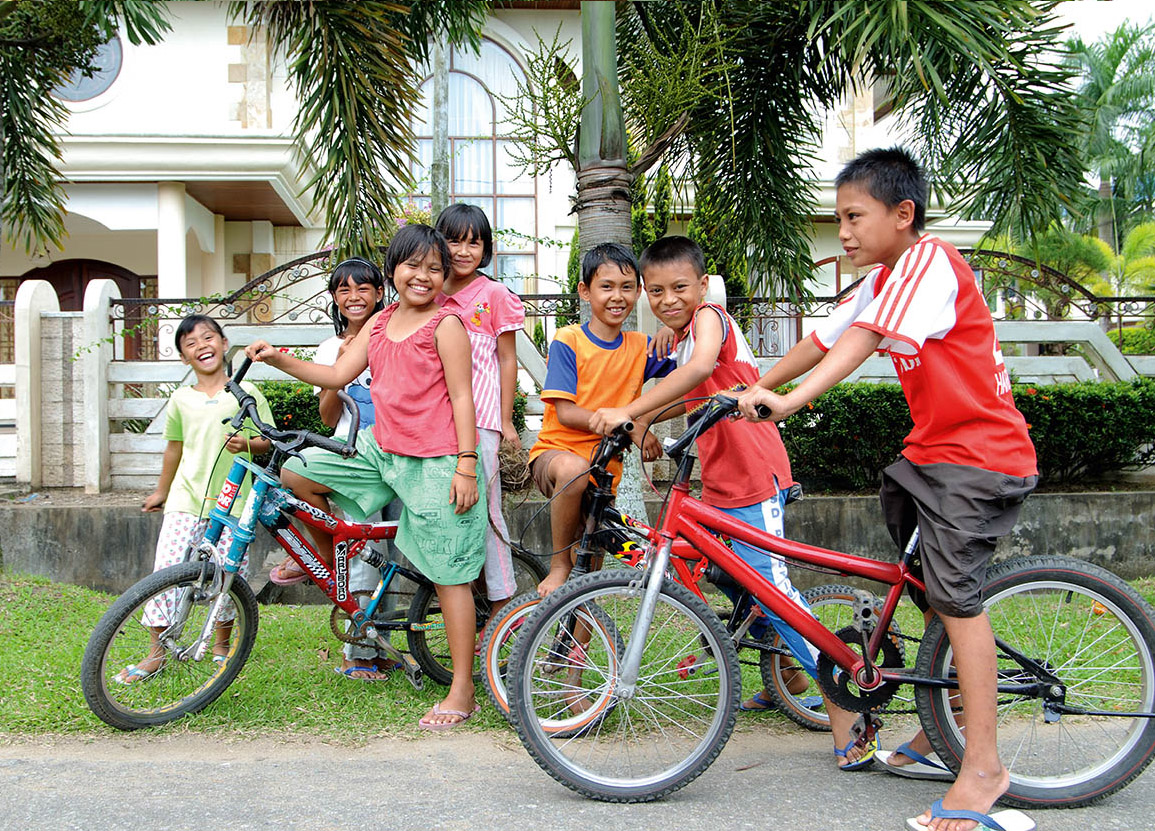
Children in Pontianak.
Alamy
Deep into Dayak land
For trips inland to Dayak country, riverboats are the generally accepted mode of transport, but facilities are geared for local travellers, and it takes 2–3 days to reach Sintang and five to six days to Putussibau. Riverboats depart from downtown Pontianak. There are now regional flights into both towns.
East of Pontianak, on the way to Sintang is Sanggau, which has an abundance of hot springs, lakes, waterfalls, caves and forests for jungle trekking. There are basic overnight facilities in Sanggau.
Sintang % [map], the home of some of West Kalimantan’s most traditional Dayak groups, is situated in the middle portion of the Kapuas Basin. It can be reached by road (12 hours by bus), small plane (about 45 minutes via a small Trigana aircraft) or boat (2 days by houseboat) up the Sungai Kapuas from Pontianak. There is a small museum in Sintang that is worth a visit, and it is possible to visit some of the area’s longhouses.
Nearby, Gunung Kelam (Dark Mountain) looms over the countryside. This superb, sheer-walled rock is a challenge for even the best climbers. For traditional Dayak country, head up the Sungai Melawi, which flows into the Kapuas at Sintang. Take either the Sungai Kayan, a tributary of the Melawi close to Sintang, or else go up the main stream of the Melawi, past Nanga Pinoh and to Gunung Schwaner. In the far upriver villages, there are carved funerary structures.
Putussibau ^ [map], the last town in West Kalimantan on the Sungai Kapuas, can be reached by plane, boat, or via bus from Sintang (about 6 hours) on a good road. From here, visit traditional Kayan villages on the Sungai Mendalam or the Maloh longhouses a short way upstream on the Kapuas. Further inland, in Gunung Muller, most Dayak have been proselytised by American fundamentalist missionaries who frown on just about all aspects of traditional life. For the adventurous, it is possible to make the week-long trek from upper Kapuas across Kalimantan to upper Mahakam.
Little-visited national parks
There are several obscure conservation areas in West Kalimantan. Travel to these regions on a budget via public transport is arduous and time-consuming, and the alternative – going by chartered vehicles and boats – is expensive. For extreme adventurers the rewards include going where few travellers dare to venture, encountering Dayak tribes and viewing wildlife that includes orang-utans and many other endangered species of flora and fauna.
Tip
Generally, the further upriver you go, the longer the delays and the more rudimentary the facilities. Take with you a good sense of humour, and be flexible.
On the border of East and Central Kalimantan, Bukit Baka-Bukit Raya contains part of the Schwaner Mountains. Bukit Raya (2,278 metres/7,474ft) is its highest point and also the habitat of sun bears, clouded leopards, agile gibbons, slow lorises and proboscis monkeys.
From Putussibau it is possible to visit two other parks. A Ramsar protected wetlands site, Danau Sentarum National Park’s importance is its seasonal lakes, freshwater swamp forest and peat swamp forest. Lying west of Putussibau near the Sarawak border, in addition to mammals and birds, the park protects at least 120 fish species, including Asian bony tongue and clown loach, as well as estuarine and Siamese crocodiles and false gharials.
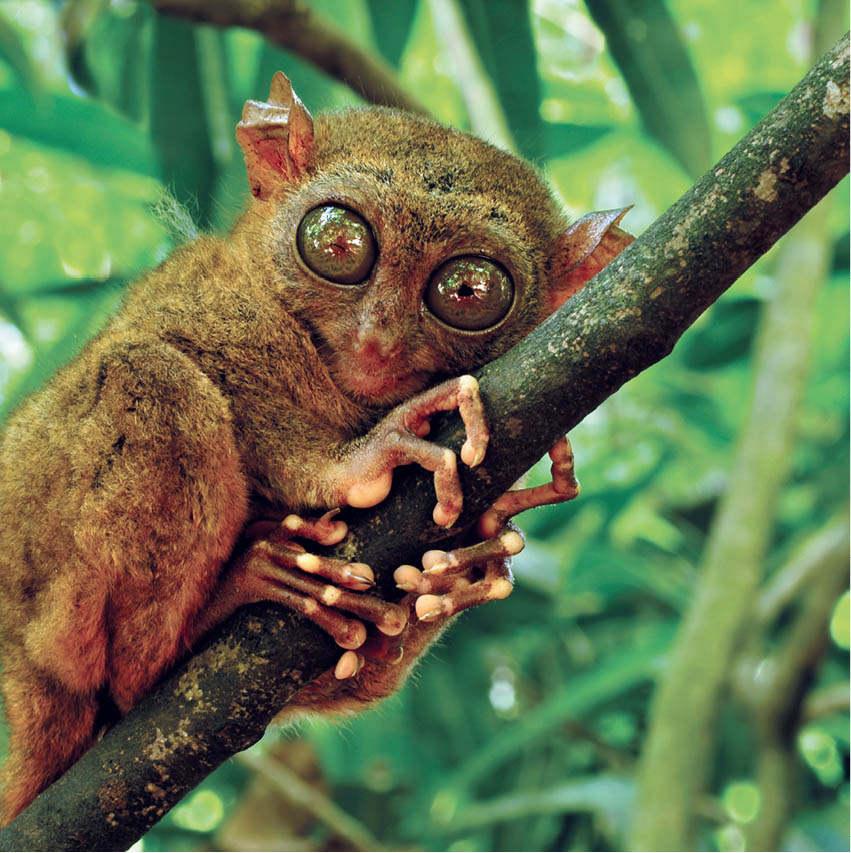
Tarsiers are nocturnal primates found in the depths of the Borneo jungle.
iStock
Betung Kerihun National Park, north of Putussibau, is also near the Malaysian border and contains both lowland and montane rainforests harbouring orang-utans, Muller’s Bornean gibbons, lorises, tarsiers and surilis. Smelly Rafflesia also grow here. Many outdoor experiences await the adventurous in this park: climbing Gunungs Lawit and Kerihun, exploring ancient caves and shooting class IV and V rapids.
South of Pontianak is Sukadana’ gateway to Gunung Palung National Park & [map]. There are homestays at Buntok and Lubak Baji. The park is a vital conservation area because of its diversity of habitats that include many ecosystems, from mangroves and swamp forests to montane forest. Thought to be the world’s largest population, orang-utans are the flagship species here, but there are also sun bears, red-leaf monkeys, crocodiles and cobras. A number of orang-utan research projects have been ongoing in Gunung Palung since 1985.
The Dayaks of Kalimantan
The term ‘Dayak’ is an amorphous one. Although its origin is unclear, ‘Dayak’ distinguishes the 200 or more ethnic groups living in the interior of Kalimantan from the coastal-dwelling Malays. While Malays make their living through trade, sea fishing and farming settled areas, the Dayak prefer to fish the rivers, hunt and gather forest produce.
The Dayak were romanticised in the past – and with good reason. They were noted head-hunting jungle warriors, lived in massive longhouses and practised strange rituals. One of the more novel practices of Dayak men was the palung, the practice of inserting objects into the foreskin of the penis as sexual enhancers. One British explorer wrote of this practice in the 19th century: ‘One lively range of objects can be so employed – from pigs’ bristles and bamboo shavings to pieces of metal, seeds and beads...’
While the palung – mostly used by the Kenyah and Kayan – never hurt a man’s chances with women, there was, however, the bride price to come up with. Back in the old days, no suitor needed to apply to marry the chief’s daughter unless he could produce several freshly severed heads. These heads were believed to be essential for the spiritual and material welfare of the village. Thankfully, for most, head-hunting is now outlawed.
